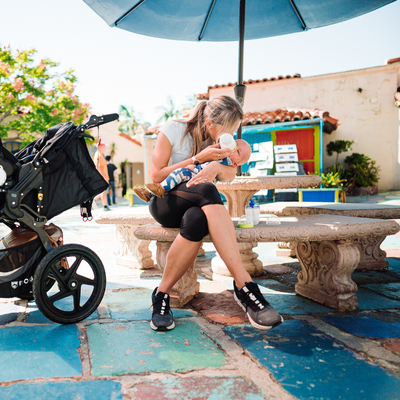
Understanding Urgent Maternal Warning Signs
FIT4MOM x Jessica Maurer
Bringing a new life into the world is a profound and life-changing experience. However, the journey doesn't end with childbirth. New mothers must stay vigilant about their health as they navigate the postpartum period. The Centers for Disease Control and Prevention (CDC) highlights the importance of recognizing urgent maternal warning signs—symptoms that could indicate potentially life-threatening conditions. Understanding these signs can be a matter of life and death, as maternal mortality rates in the United States remain alarmingly high compared to other developed countries.
THE ALARMING STATISTICS
In recent years, the maternal mortality rate in the United States has drawn significant concern. According to the CDC, approximately 700 women die each year from pregnancy-related complications. Even more alarming is that 60% of these deaths are preventable. The maternal mortality rate in the U.S. is 23.8 deaths per 100,000 live births, a figure significantly higher than in other developed nations. These statistics underline the critical need for awareness and education on urgent maternal warning signs.

WHAT ARE URGENT MATERNAL SIGNS?
The CDC has identified several urgent maternal warning signs that require immediate medical attention. These signs can occur during pregnancy, childbirth, or the postpartum period. They include:
Heavy Bleeding (Postpartum Hemorrhage): Excessive bleeding after childbirth, especially if it soaks through one or more pads per hour, could indicate postpartum hemorrhage, a leading cause of maternal mortality. This condition can result from uterine atony (failure of the uterus to contract after birth), retained placenta, or uterine rupture.
Severe Headache: A severe headache that does not go away with medication or is accompanied by vision changes or swelling could be a sign of preeclampsia, a condition characterized by high blood pressure and damage to organs like the liver and kidneys.
Chest Pain or Shortness of Breath: These symptoms can indicate a pulmonary embolism (a blood clot in the lungs), which is a leading cause of maternal mortality. Pulmonary embolism can occur during pregnancy or in the weeks following childbirth.
Swelling, Redness, or Pain in the Leg: This could be a sign of deep vein thrombosis (DVT), a condition where a blood clot forms in a deep vein, usually in the leg. DVT can lead to a pulmonary embolism if the clot travels to the lungs.
Fainting or Dizziness: Fainting, dizziness, or a rapid heartbeat could indicate severe blood loss, dehydration, or other serious conditions. These symptoms should never be ignored.
Fever: A fever higher than 100.4°F (38°C) could signal an infection, such as endometritis (an infection of the uterine lining), which can be life-threatening if not treated promptly.
Severe Abdominal Pain: Intense pain in the abdomen, especially if it is sudden or persistent, could indicate various conditions, including uterine rupture, appendicitis, or a bowel obstruction.
Thoughts of Harming Yourself or Your Baby: Postpartum depression and anxiety are serious conditions that can lead to harmful thoughts. These symptoms require immediate attention from a healthcare provider.
THE IMPORTANCE OF IMMEDIATE ACTION
Recognizing these warning signs is only the first step. Immediate action is critical to ensure the health and safety of the mother. The CDC emphasizes that if a new mother experiences any of these symptoms, she should seek medical care immediately. Delays in treatment can lead to severe complications or death.
Healthcare providers also play a crucial role in educating patients about these warning signs before discharge from the hospital. The CDC recommends that all postpartum women receive information about urgent maternal warning signs and clear instructions on when to seek medical help.
WHY ARE THESE SIGNS OFTEN OVERLOOKED?
Several factors contribute to the under-recognition of these symptoms. Many new mothers may dismiss their symptoms as part of the normal postpartum recovery process. Additionally, healthcare disparities can lead to delayed or inadequate care, particularly among women of color. Black women, for example, are three times more likely to die from pregnancy-related causes than white women, according to the CDC. This disparity underscores the need for equitable access to healthcare and culturally competent care.

THE ROLE OF SUPPORT SYSTEMS
Family members, friends, and healthcare providers must be aware of these warning signs and advocate for the mother's health. Encouraging open communication and providing emotional support can make a significant difference. Loved ones should not hesitate to urge the mother to seek medical help if they notice any concerning symptoms.
Maternal health is a critical issue that requires the attention and action of everyone involved—from healthcare providers to family members. By understanding and recognizing the urgent maternal warning signs highlighted by the CDC, new mothers can protect themselves during a vulnerable time. Immediate response to these warning signs can save lives, reducing the number of preventable maternal deaths in the United States. As a society, we must prioritize maternal health and ensure that every mother receives the care and support she deserves.
WANT TO LEARN MORE?
Bringing new life into the world is a miraculous and life-altering experience, but it's no secret that pregnancy and postpartum can bring a whirlwind of changes to a woman's body. As a fitness professional or health enthusiast, you have the power to support and empower mothers on their journey to a healthy pregnancy, a smoother birth experience, and a robust postpartum recovery.
Register here to receive more information for training the female client.
If you liked this blog, check these out:





